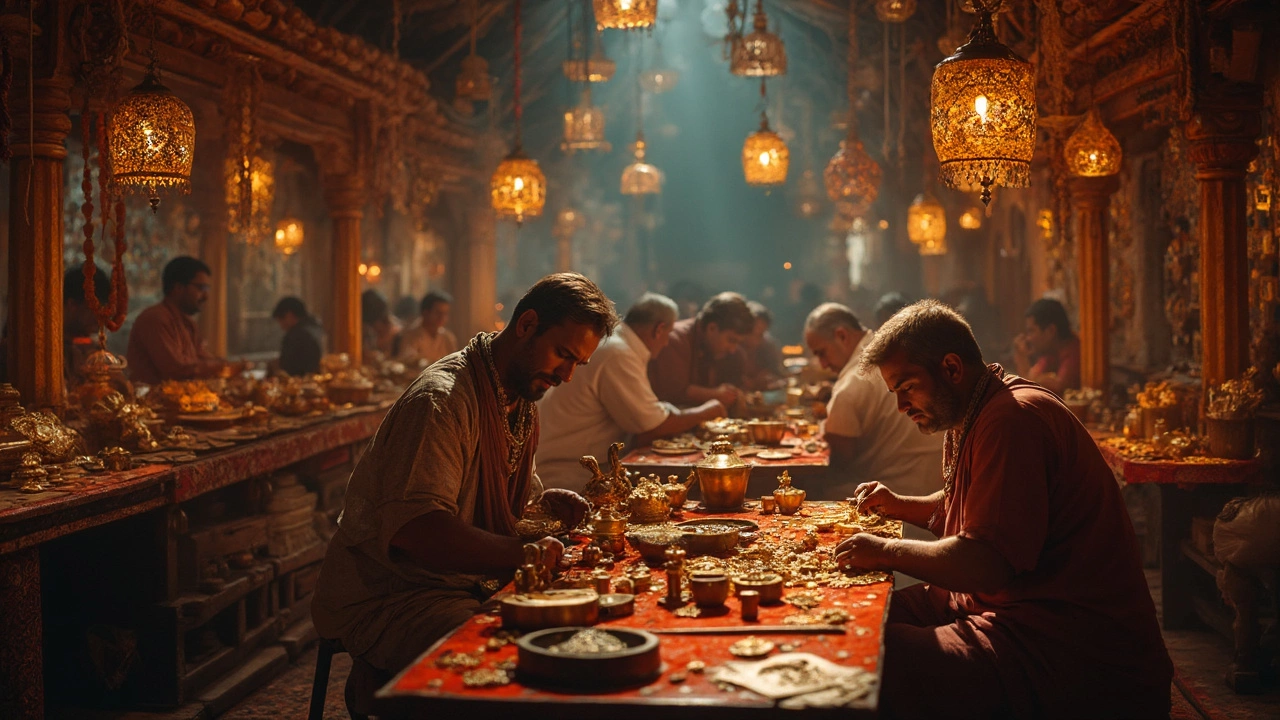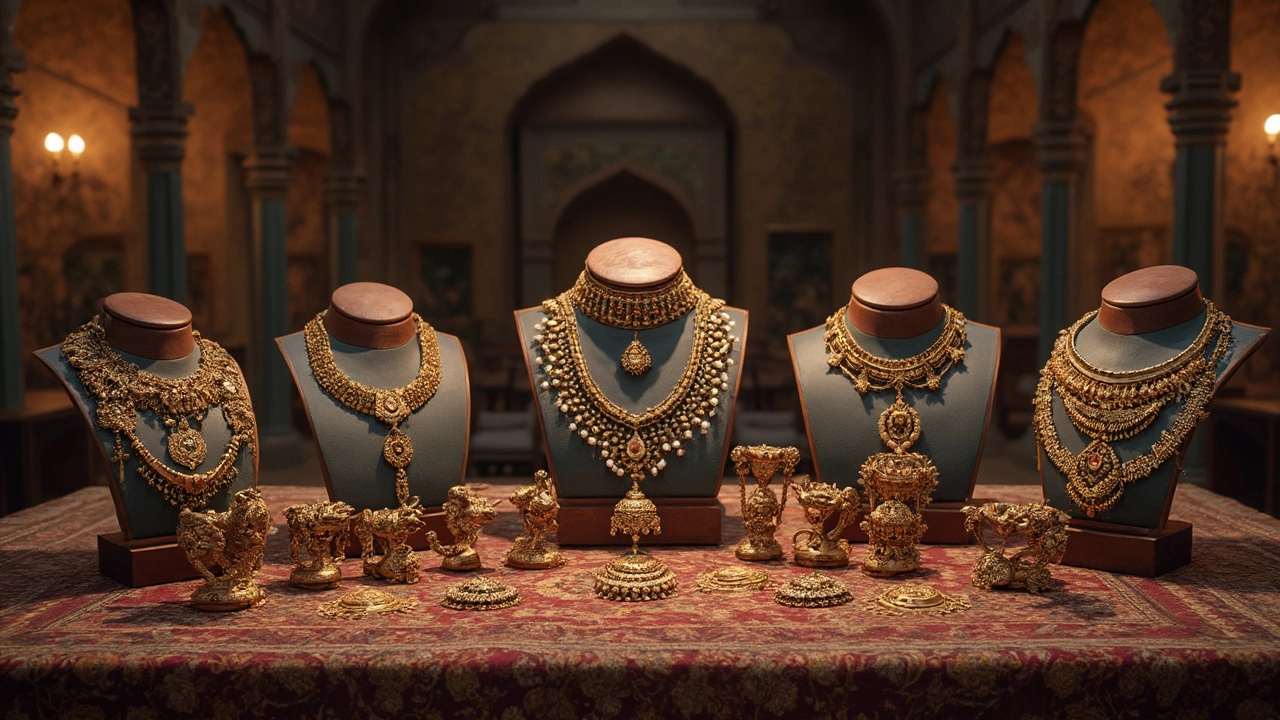
Ever wondered what the oldest piece of jewelry looks like? You’re in luck, because we're diving into history to explore spectacularly crafted ornaments created aeons ago. Let’s talk bones and stones—specifically, the 100,000-year-old jewelry made from Nassarius shells discovered in a Moroccan cave. These tiny beads may not look like much today, but they were the bling of their time, flaunted by our prehistoric ancestors.
Why are these little shells a big deal? They highlight our age-old love affair with self-adornment. It seems that even back then, people enjoyed a touch of sparkle. These beads reveal a lot about how our ancestors viewed beauty and expressed their identity. Plus, the craftsmanship back then was impressive. Imagine drilling tiny holes into shells using primitive tools. That’s dedication!
Of course, it didn’t stop with shells. The ancients got pretty creative with their materials, using bones, stones, and even teeth to craft their gems. Fast forward a few centuries, and they were working with metals like gold and silver. Each material came with its own charm and challenge, deeply influencing the art of jewelry making.
- Introduction to Ancient Jewelry
- Discovery of the Earliest Pieces
- Materials and Techniques Used
- Cultural Significance and Symbolism
- Influences on Modern Designs
- Preservation and Collecting Tips
Introduction to Ancient Jewelry
When we think of jewelry today, we often imagine dazzling diamonds and intricate metalwork. But way before earrings and necklaces hit the high streets, ancient jewelry was setting the trend, in its own way. It might surprise you to know that one of the first known pieces of jewelry is over 100,000 years old. Yeah, that much!
Picture this: early humans, sitting around a fire and deciding they needed to jazz up their outfit for the night. Enter the Nassarius shells. These aren't your typical cabin by the sea shells; they were meticulously drilled by hand to string into beads. What's fascinating is that they weren't randomly thrown together. It seems designs and patterns mattered even back then.
So, why did these ancient folks care so much about jewelry? A heap of reasons. First off, it was a sign of status and beauty. Not unlike today, wearing fanciful items set someone apart in their community. It could signify power, identity, or even tell others which group you were a part of. Talk about early LinkedIn profiles!
And let's not forget practicality. Wearing a necklace made of colorful stones or shells might have served as a talisman or even played a role in ancient rituals. Most interestingly, researchers have found pieces from different regions. This means there might have been an early trade of antique jewelry.
The materials used set the groundwork for everything that came after. Bone, ivory, and even animal teeth were just some materials in the mix. They eventually paved the way to metalworks with copper, gold, and silver. And while today's tech has made designing jewelry easier, the essence of creativity and artistry driving ancient designers was just as vibrant.
Thanks to such discoveries across various archaeological sites, like the ones in Blombos Cave, South Africa, and Skhul, Israel, we get a peek back into the style world of our ancestors, providing context for how ancient ornaments came to be what they are today.
Discovery of the Earliest Pieces
So, where did our fascination with jewelry first begin? Turns out, the search for the oldest jewelry led archaeologists to some pretty surprising places. Imagine stumbling upon a small cave in Morocco only to uncover ornaments made by humans around 100,000 years ago. Insider tip: It’s not about diamonds, but rather the humble Nassarius shells that stole the spotlight.
These tiny beads were more than just decorative; they told rich stories about the wearers and their lifestyles. Archaeologist Marian Vanhaeren, a leading voice in the field, once said,
"These shells were likely used as a form of communication and helped convey individual identity and social status long before written words."It's fascinating how something so small could be so powerful back then.
The Significance of Nassarius Shells
Nassarius shells weren’t just picked randomly. They needed a fair bit of effort and ingenuity to be fashioned into beads. The creators had to drill holes into them, and a lot of care went into stringing them, possibly into necklaces or bracelets. Imagine doing this without modern tools!
These shells even popped up in other sites like Israel and Algeria. This shows a widespread love for self-expression and connectivity among ancient communities. It tells us that being fashionable isn't just a modern construct.
Finding More Ancient Gems
Apart from shells, later discoveries in Europe revealed artifacts made of bones and stones, some even carved from mammoth ivory. Brace yourself for this: a site in Germany produced the oldest known jewelry made from bird bones, dated to be around 35,000 years old.
These finds, whether shell, bone, or stone, paint a picture of a connected world where creativity and craft knew no bounds. They also challenge our assumptions about prehistoric cultures being primitive.
If you're curious about what these findings look like, they’re not just hidden in history books. Many museums worldwide display these extraordinary pieces, offering a glimpse into a time when jewelry wasn't just about looking good—it was about telling a story.
Materials and Techniques Used
Back in the day, humans didn't have fancy equipment or materials like we do now. They got creative with what was naturally available. Some of the oldest jewelry pieces, such as the Nassarius shell beads, relied on materials like shells, bones, stones, and even animal teeth. Each of these had its own significance and practical use.
Natural Materials
No walk into the prehistoric jewelry vault would be complete without mentioning the use of bones and stones. Bones were abundant and easy to carve. Stones were also a popular choice due to their varied colors and durability. Combine these with animal teeth, and you've got the foundation for the world’s first DIY project.
Metal Makes a Debut
As time rolled on, humans started to mess around with metal. Copper was the first metal discovered, followed by gold and silver. These soft metals were simple to mold, and honestly, who doesn’t want shiny things? The metal allowed for more elaborate designs, which we still find in today’s antique jewelry.
Primitive Tools and Techniques
Creating jewelry wasn't just a walk in the park. Imagine trying to drill tiny holes into a shell or carve a piece of bone using nothing but a sharp stone or bone tool. That's some serious dedication! Techniques included basic carving, twisting, and hammering, which were surprisingly effective given their simplicity.
Fact Snippet: Metal Timeline
| Metal | Approx. Discovery Year |
|---|---|
| Copper | 8700 BC |
| Gold | 6000 BC |
| Silver | 4000 BC |
These ancient practices laid the groundwork for what would eventually evolve into the complex methods we use today. While we now have technology to thank for our detailed and intricate designs, it's kinda cool to know that even 100,000 years ago, people were determined to create beautiful things out of what they could find lying around.

Cultural Significance and Symbolism
Jewelry has always been more than just decorative; it’s soaked with cultural meaning. The oldest pieces show us that even prehistoric humans used ornaments to convey status, identity, and beliefs. Those Nassarius shell beads? They were likely symbols of social identity in the community.
Fast forward to ancient Egypt, where the jewelry was literally fit for a pharaoh. Gold was often associated with the gods, symbolizing eternity and power. Egyptians believed that wearing jewelry could help in the afterlife, guiding spirits safely to the next world. The iconic Ankh symbol, often worn as a pendant, represented life and immortality.
In ancient India, jewelry was an essential part of culture, evolving into complex designs made with precious stones and gold. They believed that each gemstone had specific powers and properties. For instance, rubies were thought to bring peace, while sapphires provided protection. These beliefs still influence jewelry choices today.
Meanwhile, the Greeks were busy making their jewelry masterpieces. They were inspired by mythology and used jewelry to tell stories and honor the gods. Laurel wreaths, often crafted from gold, symbolized victory and achievement.
It’s fascinating how the cultural significance of jewelry has transformed but remained influential throughout history. Understanding these ancient motifs gives us a deeper appreciation of the antique jewelry designs we admire today.
Influences on Modern Designs
When we talk about how ancient jewelry still inspires today's bling, it's like connecting past with present in a constant loop of creativity. The world's oldest jewelry isn't just sitting in museums; it's alive in the designs we admire and wear daily. But how exactly? Well, let's break it down.
Timeless Aesthetics
Designs from ancient eras often prioritized simplicity and raw beauty, something many modern designers crave to replicate. The use of natural shapes and materials—like shells, stones, and even bones—has found its way into contemporary pieces. These materials give jewelry an earthy, grounded feel that reminds us of our roots.
Take the boho jewelry trend that's all about organic vibes and unpolished stones. You're seeing ideas that date back thousands of years, reimagined for today's wardrobes. This connection to the past brings a unique texture and story to modern pieces, making them more than just accessories.
Symbolism and Stories
There's something about wearing a piece of ancient ornament that feels like bearing a piece of history. Modern designers often create pieces filled with symbolism inspired by ancient times, like ancient glyphs or mythological motifs.
Consider popular motifs like the evil eye, tree of life, or Celtic knots. All of these stem from old traditions, crafted to express ideas like protection, eternity, or harmony with nature. Modern jewelry designs tap into this rich tapestry of stories to convey deeper meanings, resonating with wearers who love a good story behind their bling.
Innovative Craftsmanship
The techniques from centuries ago also shine through today's works. Although we've got fancy tools now, the precision and dedication of ancient artisans continue to inspire meticulous handiwork. Techniques like hand-knotting or filigree work have ancient origins and are staples in the jeweler's toolbox.
Contemporary designers often use historical crafting techniques to echo what made antique pieces so stunning, breathing new life into age-old practices. This blend of old with new makes today's jewelry designs a bridge between eras, capturing timeless beauty in innovative ways.
Preservation and Collecting Tips
If you're fascinated by ancient ornaments and want to preserve your own collection of antique jewelry, you've got to be keen on proper care and maintenance. These relics have survived centuries, so it’s crucial they’re treated with respect to last even longer.
Proper Storage
For starters, keep your pieces in a cool, dry place. Humidity is no friend to materials like silver or pearls. A good-quality jewelry box lined with fabric can work wonders. Avoid storing them in plastic or airtight containers as these may trap moisture.
Handling with Care
Believe it or not, your skin's oils can affect antique pieces over time. Wash your hands before handling them and try to limit how often you wear them. Also, apply any perfumes or lotions before donning your jewelry to minimize chemical exposure.
Cleaning Techniques
When it comes to cleaning, less is more. Use a soft, lint-free cloth to gently wipe your pieces. For more detailed cleaning, opt for a mixture of mild soap and water. But remember, avoid soaking for too long, especially with porous stones or delicate settings.
Expert Appraisal and Insurance
Securing an expert appraisal of your ancient treasures is wise. This helps not only in understanding their value but also in obtaining the right insurance coverage. Keep documents in a safe place, and update appraisals regularly, especially after market fluctuations.
Starting Your Collection
For those new to collecting, familiarize yourself with reliable dealers. Authenticity is key, so purchasing from reputable sources is crucial for avoiding counterfeits. Attend auctions, visit antique theaters, or explore online marketplaces dedicated to genuine antiques.
| Storage Method | Benefits |
|---|---|
| Fabric Lined Box | Prevents scratches and minimizes humidity |
| Avoiding Plastic | Reduces risk of moisture damage |
Diving into the world of antique jewelry is like owning a piece of history. With the right approach and care, these ancient ornaments can be cherished by generations to come.


